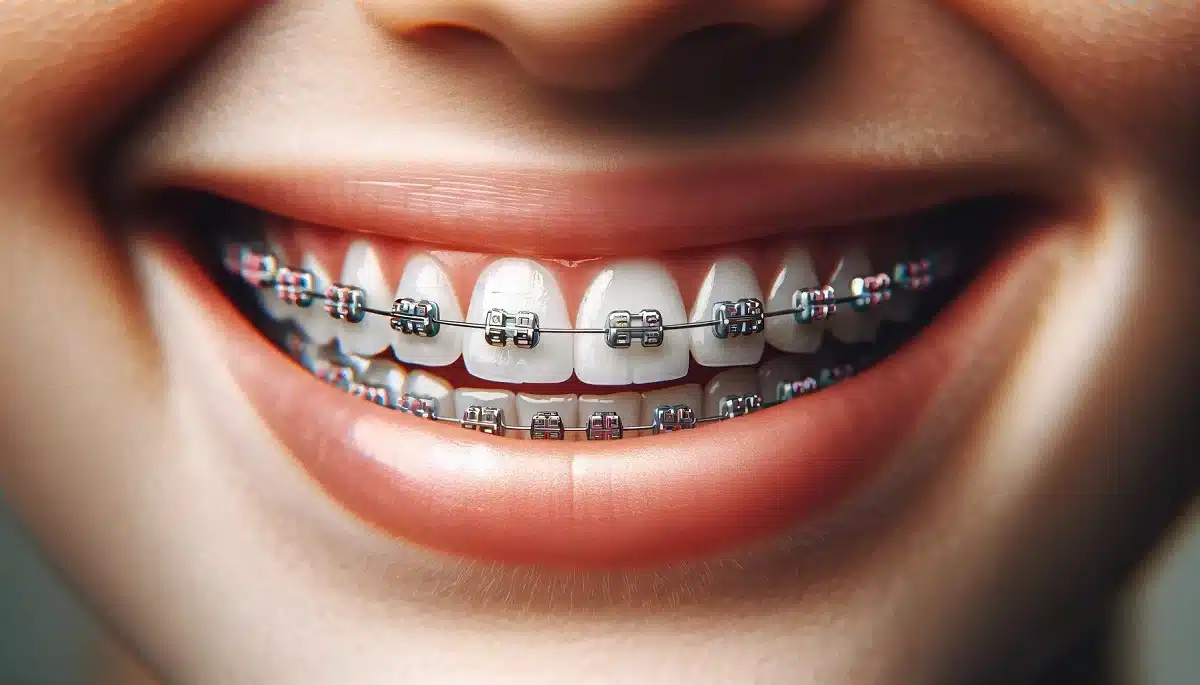Orthodontics is a branch of dentistry aimed at achieving ideal dental alignment and facial aesthetics from both an aesthetic and functional perspective. This field focuses on aligning teeth and jaws properly, improving both the appearance and oral health of individuals. Orthodontics significantly enhances a person’s bite structure and overall facial aesthetics by ensuring the correct alignment of teeth and jaw structure.

What is Orthodontics and What Does It Study?
Orthodontics, literally meaning “straight teeth,” refers to the dental specialty dedicated to positioning teeth and jaws into their correct locations. Orthodontics offers treatments designed to correct conditions such as crooked teeth, overbite (where upper teeth excessively overlap lower teeth), and underbite (where lower teeth protrude beyond the upper teeth).
Role in Dentistry
Orthodontics is recognized as a crucial specialty within dentistry. It works integratively with other dental disciplines and contributes to improving patients’ overall oral health.
Features of Orthodontics
Orthodontics involves a comprehensive evaluation and treatment process. This process examines not only the teeth but also the jaw structure and bite relationships. Treatment methods include fixed appliances (braces), removable devices, and modern approaches such as clear aligners (e.g., Invisalign).
Treatment Tools and Techniques
- Brackets : Metal or ceramic brackets are bonded to the surface of the teeth and, along with wires passed between them, gently pull the teeth into the correct position.
- Clear Aligners : Clear aligner systems, such as Invisalign, are especially popular among adult patients because they are an inconspicuous treatment method.
- Functional Appliances : These are devices that regulate jaw development and are generally used in children.
History of Orthodontics
The practice of orthodontics has existed in various forms throughout history. However, modern orthodontics began to take shape towards the end of the 18th century, especially with the invention of devices such as braces. The 20th century was a period in which significant technological developments took place in the field of orthodontics. Especially with the development of digital technologies and material science, more effective and comfortable treatment methods have been developed.
Important Milestones
- 1900s : Angle classification was adopted as a standard for describing malocclusions.
- 1930s : The first clear orthodontic brackets were introduced.
- 2000s : Digital orthodontics and personalized 3D printed devices began to be used.
Benefits of Orthodontics
- Aesthetic Improvement : Properly aligned teeth provide a more attractive smile.
- Functional Improvements : Improves correct bite, chewing and speech functions.
- Oral Health : Regularly aligned teeth make teeth cleaning easier and reduce the risk of periodontal disease.
Orthodontic Treatments and Techniques
Orthodontics uses a variety of treatment methods and techniques to correct tooth and jaw irregularities. These treatments aim to improve a person’s dental health, functionality and aesthetic appearance. Here are some common appliances and techniques used in orthodontic treatments:
Fixed Orthodontic Appliances: Brackets and Wires
Fixed orthodontic appliances are one of the most commonly used orthodontic treatment methods. This method is especially effective in correcting crooked teeth and jaw alignment.
- Brackets : Brackets are small metal or ceramics that are bonded to the front surface of the teeth. Each bracket works with wires to gradually pull the teeth into the desired position.
- Wires : Wires are attached to brackets and slowly move the teeth by applying constant pressure. These wires are adjusted over time, thus helping the teeth and jaws move to the desired position.
- Ligature Elastics : Small elastic or metal rings used to attach brackets to wires. These elastics allow the wires to fit tightly into the brackets and regulate the pressure on the teeth.
Movable Apparatus: Retainer and Functional Devices
Another important part of orthodontic treatment is removable appliances. These devices, unlike fixed appliances, can be removed by patients.
- Retainers : Retainers used in the final stage of orthodontic treatment are designed to maintain the newly aligned positions of the teeth. It reduces the risk of teeth returning to their previous positions after treatment.
- Functional Appliances : These are mobile devices used to regulate jaw development, especially in children and adolescents. These appliances help the upper and lower jaw grow more harmoniously relative to each other.
Clear Corrective Plates: Invisalign and Alternatives
Transparent corrective plates offer an aesthetic alternative in orthodontic treatment. This method is especially popular among adult patients.
- Invisalign : Invisalign are corrective plates made of clear plastic. These aligners fit tightly over the teeth and are designed to be difficult to notice. The aligners are replaced with a series of aligners, each of which moves the teeth a certain amount.
- Alternative Clear Aligner Systems : Apart from Invisalign, there are various clear corrective aligner brands on the market. These include systems such as ClearCorrect and SmileDirectClub. Each works on a similar principle, but may differ in cost, duration of use and design.
Orthodontic treatments are customized according to the individual’s needs and the characteristics of their dental health. In addition to making teeth look straighter, these treatments are also important for maintaining and improving oral health. Each treatment method is selected taking into account the patient’s lifestyle, treatment needs and aesthetic preferences.
Orthodontic Problems and Diagnostic Methods
Crooked Teeth and Malocclusion Types
Orthodontics is the branch of dentistry that corrects improper alignment of the jaw and teeth. Orthodontic problems are often referred to as malocclusion, meaning that the teeth are not aligned properly on the jaw.
- Crooked Teeth : Irregular growth of teeth due to crowding or insufficient space. This situation makes teeth cleaning difficult and paves the way for periodontal diseases.
- Types of Malocclusions : Malocclusions generally fall into three main categories: Class I, II, and III. Class I refers to slight crowding between the teeth, Class II generally describes overbite (upper teeth protruding forward relative to the lower teeth), and Class III describes underbite (the lower teeth being further forward than the upper teeth).
Diagnostic Methods: X-Ray, 3D Imaging and Dental Impressions
The techniques used in the diagnosis of orthodontic problems allow dentists to accurately detect the problem and create an appropriate treatment plan.
- X-Ray : Traditional imaging method that shows the tooth and jaw structure in detail.
- 3D Imaging : It is used to examine the jaw structure in three dimensions and provides a more detailed analysis.
- Dental Impressions : Copies of the teeth and jaw are taken and used in the production of the equipment required for treatment.
Approaches in Orthodontic Treatment by Age Groups
Orthodontic treatment can be applied to all age groups; However, treatment approaches may vary depending on age.
Orthodontics in Children and Adolescents
- For children and adolescents, orthodontics is often more effective due to incomplete jaw development.
- Early intervention can help prevent future dental problems and often requires less invasive treatments.
Adult Orthodontics: Challenges and Solutions
- Orthodontic treatment in adults may be more difficult due to the less flexible jaw structure.
- Due to aesthetic concerns, adult patients generally prefer more inconspicuous treatment methods such as transparent aligners.
Effects of Orthodontic Treatment on Health
Benefits for Oral and Dental Health
- Properly aligned teeth make cleaning easier and prevent gum disease.
- A properly aligned bite reduces tooth wear and breakage.
Indirect Effects on General Health
- Straight teeth improve digestion because food can be chewed more effectively.
- Improving oral health may reduce the risk of systemic diseases such as heart disease and diabetes because chronic inflammation is reduced.
Orthodontics not only improves the appearance of teeth, but also contributes positively to the general health of individuals. By correcting tooth and jaw irregularities, the treatment improves patients’ quality of life and provides long-term health benefits.
Orthodontic Treatment Process and Management
Treatment Planning and Process Monitoring
The orthodontic treatment process requires a customized approach based on individual needs. A detailed examination and evaluation is performed for each patient, and a treatment plan is created as a result of these evaluations.
- Initial Evaluation : A detailed oral examination, x-ray and 3D images are taken to understand the patient’s teeth and jaw structure.
- Treatment Plan : Brackets, transparent plates or other orthodontic devices are determined according to the patient’s condition.
- Process Monitoring : Regular checks are made during the treatment, and in these checks, the movement of the teeth and the progress of the treatment plan are monitored.
Care Recommendations and Lifestyle Changes for Patients
Patient care during and after orthodontic treatment is critical to the success of the treatment.
- Oral Hygiene : If brackets or clear aligners are used, teeth and orthodontic appliances need to be cleaned regularly.
- Eating Habits : Avoiding hard, sticky or sugary foods reduces the pressure on the teeth and prevents damage to the appliances.
- Regular Checkups : Regular dentist visits are important to support the treatment process and detect possible complications early.
Orthodontics and Aesthetics
Today, orthodontic treatments not only make functional corrections but also address aesthetic concerns.
Smile Design and Aesthetic Orthodontics
- Individual Aesthetic Goals : Personalized smile designs are made according to the patients’ facial shapes and aesthetic expectations.
- Modern Orthodontic Solutions : Modern treatment methods such as transparent plaques and lingual brackets address the aesthetic concerns of patients by reducing visibility.
Aesthetic Concerns and Psychological Effects
- Confidence Increase : A smooth smile can positively affect individuals’ self-confidence and social interactions.
- Psychological Comfort : An aesthetically pleasing result can improve overall quality of life and psychological health.
Post-Orthodontic Care and Follow-up
After orthodontic treatment is completed, important steps must be taken to ensure the permanence of the results achieved.
Retention Phase and Post-Care Needs
- Retainer Use : To prevent the teeth from returning to their previous positions after treatment, most patients receive a retainer (fixed or removable) to be used at night.
- Long-Term Monitoring : Regular dentist visits are important for potential adjustments and help maintain dental health.
Orthodontic treatment is a complex process that requires comprehensive planning, regular follow-up and meticulous care. Patient cooperation and physician guidance at every stage of treatment ensures optimal results.
Conclusion
Orthodontics is not only an aesthetic discipline but also a critical healthcare service that provides functional improvements. Supported by modern technologies, this field continues to significantly improve both the appearance and quality of life of patients. Orthodontic treatments help individuals maintain their long-term oral health while increasing their self-confidence.
Warning: This article is for informational purposes only and is not a substitute for professional medical advice, diagnosis, or treatment. If you have any health questions or concerns, please consult your physician or healthcare provider. This content is intended to provide general information to readers and is not personalized to the reader’s particular health condition.






